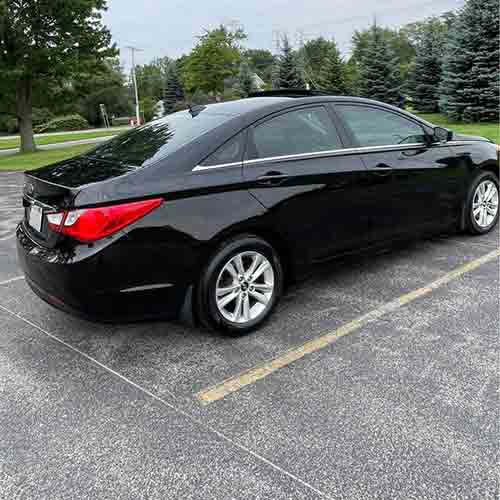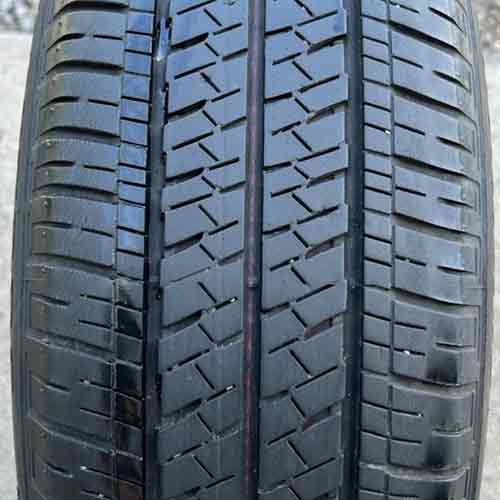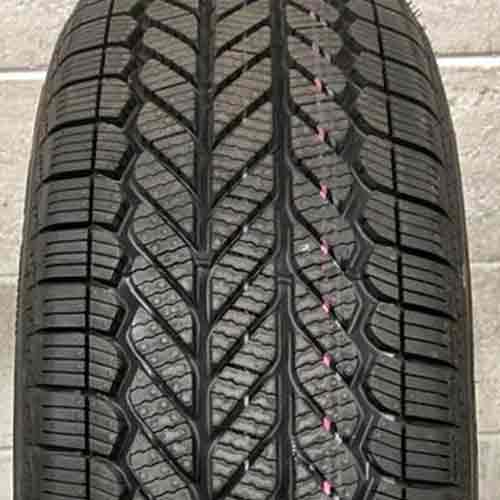The Bridgestone Ecopia is designed with fuel efficiency and environmental consciousness in mind, whereas the Bridgestone Weatherpeak is a tire designed for a relatively better all-season performance. Let’s see which of these tires, is a better fit for you.

Table of Contents
Info on Sizes
The Bridgestone WeatherPeak comes in 15 to 20 inches having following specs.
- Speed ratings: T, H and V.
- Load ratings: SL and XL.
- UTQG: 700 A A.
- Tread depth: 10/32″.
- Weight range: 17 to 30 lbs.
- Winter ratings: Yes both M+S and 3PMSF available.
- Tread warranty: 70k miles.
Review this tire in detail: https://tiredriver.com/bridgestone-weatherpeak-review/
The Bridgestone Ecopia EP422 Plus on the other side, has following features.
- Rim sizes: 15 to 17 inches.
- Speed ratings: T, H and V.
- Load ratings: SL and XL.
- UTQG: 540 A A.
- Tread depth: 10 and 11/32″.
- Weight range: 16 to 24 lbs.
- Winter ratings: None.
- Tread warranty: 70k miles.
Side Note: None of these tires were able to make it to my list of top grand touring tires (category where both boys here belong to). Check out the list here: https://tiredriver.com/best-grand-touring-all-season-tires/
Tread Life

Evaluating a tire involves a detailed analysis of its tread life, which is affected by various factors such as Uniform Tire Quality Grading (UTQG), tread depth, rolling resistance, and tread composition.
However, when comparing tires from different manufacturers, UTQG ratings may not be a reliable point of comparison.
But they are useful for comparing tread life when the tires are from the same company, like our two Bridgestone tires in this case.
Here, the WeatherPeak offers an impressive UTQG rating of 700, while the Ecopia is rated at 540.
This suggests that the WeatherPeak’s tread life is estimated to be 7 times longer than the standard reference tire used in testing, while the Ecopia EP422 Plus is expected to last 5.4 times as long.
This is mainly because the WeatherPeak features a more advanced, wear-resistant tread compound. Its tread compound is more elastic, slowing down wear over time.
Though both tires have similar treadwear warranties of 70k miles.
Ride Quality
Ride quality encompasses several factors, including noise levels, comfort, and the ability to absorb impacts. Let’s examine each of these aspects.
Tread Noise
Air is the primary source of tread noise. These air particles enter, (mainly through the shoulder gaps) and collide with the surrounding walls, generating noise.
Therefore, it is logical that the Bridgestone Ecopia EP422 Plus outperforms in this category.
I mean, although both tires have significant voids on the shoulders, the WeatherPeak still has relatively larger gaps, permitting more air particles to enter.
Additionally, its softer compound reflects air particles more, resulting in larger in-groove resonance.
Note: The noise difference is only marginal because WeatherPeak comes with a slightly rounded contact patch, which
On-Road Vibrations
The smoothness of a tire’s ride correlates directly with its ability to manage road irregularities, which is heavily influenced by its internal and external composition.
That’s why tires with a more pliable inner/outer construction generally provide a more comfortable driving experience.
That’s why it makes sense why the Bridgestone WeatherPeak is the better choice here.
This tire’s tread has greater silica composition, and internally it features a relatively more absorbent cap ply. Both of these offer superior vibrations soaking abilities.
On the other hand, the Bridgestone Ecopia EP422 Plus, although it has a softer internal casing internally, its stiffer rubber on top still doesn’t let it offer better impact comfort performance in comparison.
Wet Traction
Wet performance is predominantly determined by two factors: hydroplaning resistance and wet grip. Let’s assess each of these elements.
Wet Grip

Wet grip is fundamentally reliant on sipes.
And so unfortunately, the Bridgestone Ecopia EP422 Plus falls short in this regard due to its relatively fewer sipes, especially towards the tire’s shoulders, affecting its overall wet handling proficiency.
But why sipes are so important here? Well because these are tiny slits in the tread, which act as water vacuums, absorbing particles to facilitate tread contact with the surface.
And yes, their flexibility is also crucial, as they need to flex (contract/expand) to create that needed suction.
Now the Ecopia still shows up with adequate wet grip, as braking distance tests show, its handling times is lacking compared to WeatherPeak.
Not only the tire has fewer shoulder siping, but those sipes are also rectilinear. And such siping structure tend to get stiffened up on sharper turns, restricting flexibility.
On the other side, the Bridgestone WeatherPeak excels with its full-depth interlocking sipes, delivering superior handling performance in various wet conditions.
Hydroplaning
Hydro or aquaplaning happens when a tire starts to float over watery surface. And here, again the Bridgestone WeatherPeak is taking the lead.
The tire simply put has a more voided up structure, where it creates a web of grooves running in all directions. This allows for water to have multiple pathways to leave out quicker.
On the other side, the Bridgestone Ecopia EP422 Plus with its continuous longitudinal ribs obstructs efficient water removal, especially sideways. This explains why the tire demonstrates better float speeds in straight aquaplaning tests compared to curved ones.
And yes, this also further explains its lacking wet traction. Basically more water going out through grooves means less water would be there for the sipes to handle. And since its water evacuation is relatively slower, it limits the wet handling and griping.
Fuel Consumption
Fuel consumption is significantly influenced by rolling resistance, and this variable is largely determined by a tire’s internal and external makeup.
The overall makeup basically tell you about the tire’s weight, and how sticking it is with the ground.
Considering this, the Bridgestone Ecopia EP422 Plus has a slight advantage due to its lighter overall structure. This results in less weight pressure on the lugs, as they interact with the surface, leading to lower rolling resistance values.
And since the tire features a firmer tread compound, the lugs aren’t as susceptible to bending, which basically eats away the energy (that could have been used in to tire rolling).
On the flip side, the Bridgestone WeatherPeak not only comes with a more pliable tread compound, its aggressive aggressive tread pattern and heavier weight creates a lot more rolling resistance values. And so you get limited fuel economy here.
Winter Performance
When it comes to winter traction, the Bridgestone WeatherPeak is pretty great, as its more voided up lugs are able to scoop up slush and snow as the tire rolls, more effectively.
This basically creates a better forward momentum compared to its counterpart. This explains why it is the only tire in this comparison with a 3 peak mountain snowflake (3PMSF) rating.
3PMSF rating is not a test related to braking and handling/cornering, it only tells you about the acceleration, that its 10% better (on average), compared to all season tire without this rating.
Now besides creating better acceleration, the WeatherPeak also offers better snow to snow contact as well. It’s greater weight, and narrower section width (on average), allow for more effective lodging of snow particles in the tread voids.
And as snow sticks better to snow, the tire is able to create better friction with the ground.
On the other side, the Ecopia is not only lacking these features, but it also has less more thermally adaptive rubber, so in freezing temperatures, all its biters and snow vices aren’t able to remain as flexible as its counterpart, limiting grip on snowy surfaces.
Take Home Points
Both tires exhibit specific strengths and weaknesses across various categories. Let me summarize those for you.
Simply put, the Bridgestone WeatherPeak demonstrates superior tread life, on-road vibrations management, wet traction, and winter performance, while the Ecopia EP422 Plus outperforms in tread noise, hydroplaning resistance, and fuel consumption.
With a more advanced tread compound, full-depth interlocking sipes, and winter tire-like siping contribute to its extended lifespan, superior handling in wet conditions, and above average winter performance.
Whereas the Ecopia EP422 Plus having a lighter structure, and larger shoulder gaps contribute to its impressive hydroplaning resistance, marginal noise levels, and lower rolling resistance, translating to better fuel economy.